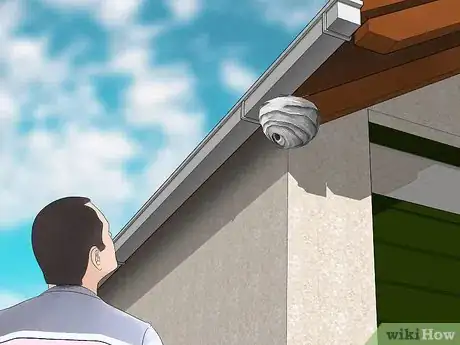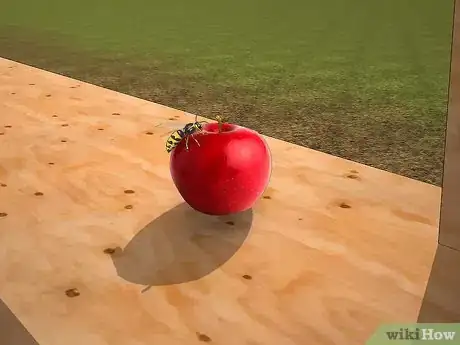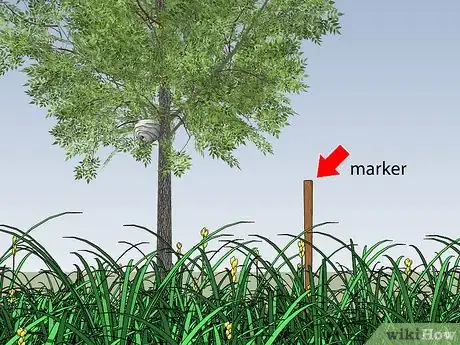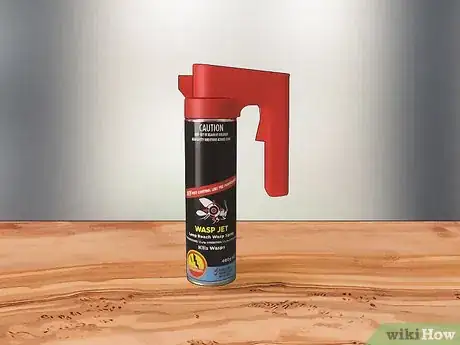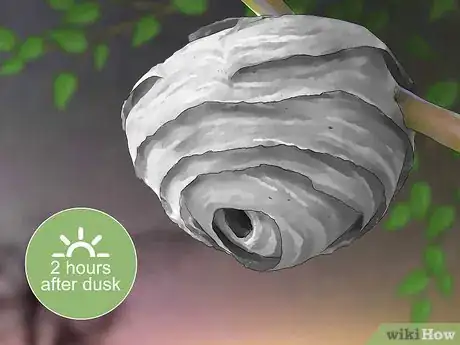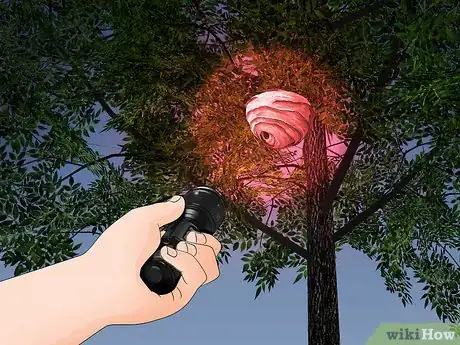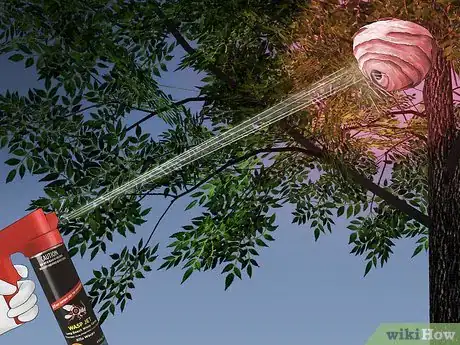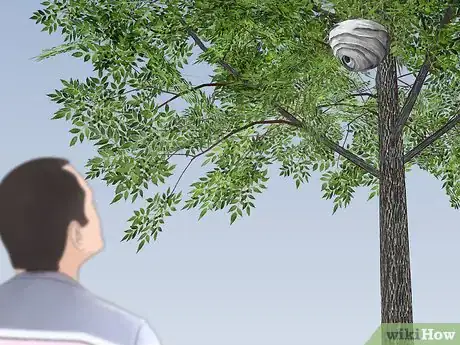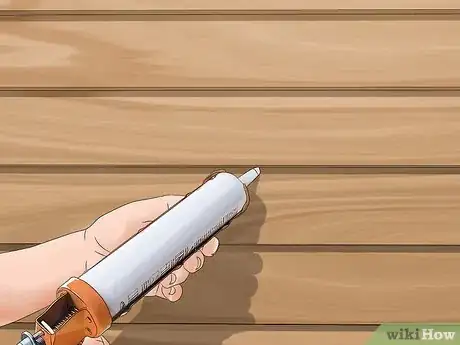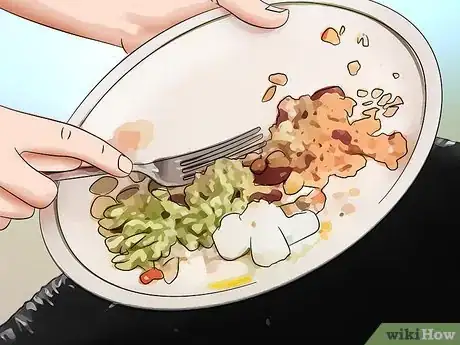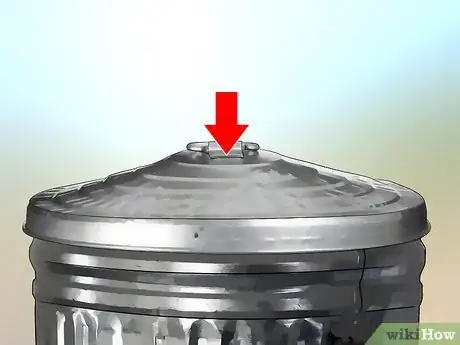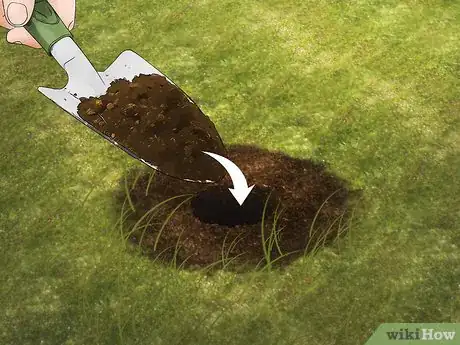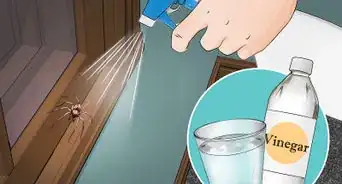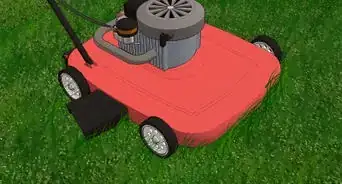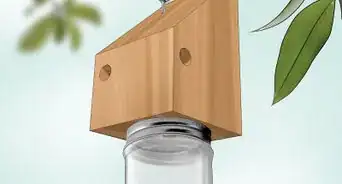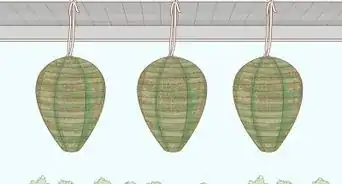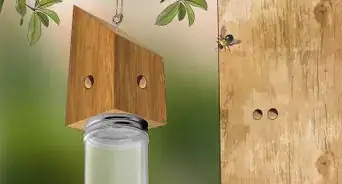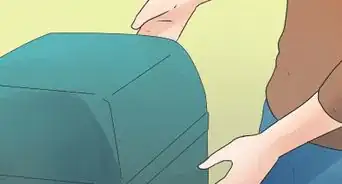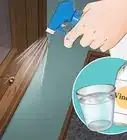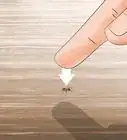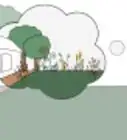This article was co-authored by Scott McCombe. Scott McCombe is the CEO of Summit Environmental Solutions (SES), a family-owned local pest solutions, animal control, and home insulation company based in Northern Virginia. Founded in 1991, SES has an A+ rating with the Better Business Bureau and has been awarded “Top Rated Professional,” and “Elite Service Award" by HomeAdvisor.
There are 9 references cited in this article, which can be found at the bottom of the page.
wikiHow marks an article as reader-approved once it receives enough positive feedback. This article received 21 testimonials and 99% of readers who voted found it helpful, earning it our reader-approved status.
This article has been viewed 1,269,507 times.
If you've noticed hornets buzzing around your yard and want to get rid of them, track them back to their nest. Spray the nest at night with an aerosol insecticide labeled for wasps and hornets. Be sure to wear thick protective clothing when you approach the nest, and avoid getting too close to it. If the nest is a safe distance from your home, consider leaving it alone. Hornets eat other insects and pollinate flowers, so they're an important part of the ecosystem.
Steps
Locating the Nest
-
1Scout for small nests on your property in the early spring. Hornet nests are small and easier to remove in the early spring. A nest that's around the size of a ping pong ball probably only contains a queen and unhatched eggs, so you can just spray it down with a hose.[1]
- You'll need insecticide to get rid of a larger nest. By summer, nests can grow to the size of a basketball and contain thousands of hornets.
-
2Wear protective clothing when you search for and treat the nest.[2] At a minimum, wear a thick, long-sleeved shirt, pants, thick leather or rubber gloves, and boots. Coveralls can add extra protection, and a beekeeper's veil can protect your head and face.[3]
- If you can't access a veil, you should wear protective goggles and a hat that covers your ears.
- To prevent hornets from getting into your clothing, use rubber bands or duct tape to secure your sleeves to your gloves and your pants to your boots.
Advertisement -
3Lure and track the hornets if you don't know the nest's location. If you've seen hornets buzzing but aren't sure where the nest is, observe which direction they fly. When they find food, hornets collect what they can and bring it back to the nest.[4]
- Try leaving out bait, such as pieces of fruit or meat, then watch it from inside your home. When hornets show interest, look for the direction they fly away, then follow them. Eventually, you should be able to track down the nest.
-
4Place a marker 15 to 20 ft (4.6 to 6.1 m) away from the nest. A hornet's nest is gray or beige, shaped like a rounded teardrop, and can be as large as a basketball. They usually hang from trees, but you might find one on the ground. Once you find the nest, stay a safe distance away, and mark your spot so you can find the nest later.[5]
- While you're at the nest, see if you can find the opening. Hornet nests usually have a single small opening toward the bottom. You might want to use binoculars to look for the hole so you don't have to get too close.
- You'll need to apply insecticide at night, so mark your spot with a brightly colored flag that you'll be able to see in the dark.
Applying Insecticide
-
1Purchase an aerosol insecticide with a 15 to 20 ft (4.6 to 6.1 m) range. Find a pressurized can of aerosol insecticide labeled for wasps and hornets at a home improvement store or garden center. Check the label, and make sure that it produces a solid stream that reaches at least 15 ft (4.6 m).[6]
- You'll need a long-range aerosol insecticide so you can target the nest without getting too close.
- Read the instruction label and use your product as directed.
-
2Treat the nest with insecticide at night.[7] The best time to treat a hornet nest with insecticide is around 2 hours after dusk. Hornets are least active at night, and most of the workers return to the nest after dusk.[8]
- Since they remain active after sunset, European hornets are an exception to this rule.[9] For this species, the best time to spray is just before sunrise when it's still dark.
- European hornets can grow over 1 in (2.5 cm) in length, and have a reddish-brown head and thorax (the middle section of the body). Other wasps and hornets don't have this reddish-brown coloring.[10]
-
3Use a flashlight with a red filter to find the nest. Hornets have trouble seeing red light, so secure a sheet of red cellophane over your flashlight with a rubber band. That way, you'll be able to see where you're going without disturbing the nest.[11]
- You'll attract unwanted attention if you use an unfiltered flashlight.
- Remember to wear protective clothing when you approach the nest. Keep in mind treating a hornet or wasp nest yourself is risky, and protective clothing does not make you invincible.
-
4Aim the insecticide stream at the nest's opening. When you locate your marker and find the nest, try to track down the opening. Again, binoculars can help you get a good view without getting too close. When you find the opening, spray a steady stream of insecticide at it for at least 5 to 10 seconds.[12]
- The goal is to keep the nest intact as you soak the opening. That way, any hornets that come out and try to attack with come into contact with the insecticide.
- Do your best to hold the stream for several seconds, but don't stick around longer than necessary. If you hear angry, swarming hornets, cover your head with your hands and run toward shelter.
-
5Check the nest after at least 1 day, and reapply insecticide if necessary. Wait 24 to 48 hours, then head back to the nest to check your work. If you see any remaining active hornets, go back to the nest after dark and apply more insecticide.[13]
- Larger nests might take 2 or 3 applications. When you're sure the nest is vacant, swat it down from a tree branch or, if it's on the ground, cover it with soil.
Deterring Hornets in the Future
-
1Caulk and seal cracks in your home.[14] In the late winter or early spring, survey your home and any other structures on your property, such as sheds. Check for cracks in the siding, roof line, eaves, and soffits, and seal any openings you find with waterproof caulk.[15]
- Use 1⁄8 inch (0.32 cm) gauge wire mesh to cover any large openings or vents.
-
2Eliminate sources of food and water. Avoid leaving out food or containers that held food, especially meat and other sources of protein, fruit, and sugary drinks. Ensure hoses and other water fixtures don't leak, and promptly remove any puddles of water that collect in your yard.
- Additionally, if you have any outdoor pets, don't leave food outside for them. Food and water will attract hornets.
-
3Keep your garbage and recycling bins tightly sealed. It's especially important to keep trash and recycling bins tightly covered if they hold food waste or containers that held sweet beverages. You should also check the bins' exteriors routinely for spilled food or liquid. Hose down your bins thoroughly if you notice any residue.[16]
-
4Fill rodent burrows and crevices with soil. Burrows and other nooks and crannies can attract ground-nesting hornets and wasps. Check your yard in the early spring, and fill in any crevices you find.[17]
- Continue to check for holes throughout the spring and early summer.
Expert Q&A
Did you know you can get expert answers for this article?
Unlock expert answers by supporting wikiHow
-
QuestionHow can I get rid of hornets naturally?
 Scott McCombeScott McCombe is the CEO of Summit Environmental Solutions (SES), a family-owned local pest solutions, animal control, and home insulation company based in Northern Virginia. Founded in 1991, SES has an A+ rating with the Better Business Bureau and has been awarded “Top Rated Professional,” and “Elite Service Award" by HomeAdvisor.
Scott McCombeScott McCombe is the CEO of Summit Environmental Solutions (SES), a family-owned local pest solutions, animal control, and home insulation company based in Northern Virginia. Founded in 1991, SES has an A+ rating with the Better Business Bureau and has been awarded “Top Rated Professional,” and “Elite Service Award" by HomeAdvisor.
Pest Control Specialist
Warnings
- Hornets can become aggressive when their nest is threatened. Plan exit routes in advance in case they swarm when you spray the nest.[20]⧼thumbs_response⧽
- Call a professional if you're dealing with a nest that's high up in a tree or in a structure, such as inside a wall or attic. Additionally, never attempt to remove a nest if you're allergic to bee, wasp, or hornet stings.[21] [22]⧼thumbs_response⧽
- Some professional exterminators make use of the bag technique, which involves enclosing the nest in plastic bag and cutting it from its branch. This method is best left to professionals; do not attempt it on your own.[23]⧼thumbs_response⧽
- Never climb on a ladder in an attempt to remove a nest. If hornets attack, you might fall and suffer a serious injury.[24]⧼thumbs_response⧽
Things You'll Need
- Protective clothing
- Brightly colored flag or other marker
- Flashlight covered with red cellophane
- Aerosol insecticide labeled for wasps and hornets
- Binoculars (optional)
References
- ↑ https://utahpests.usu.edu/uppdl/files-ou/factsheet/Yellowjackets%20Hornets%20and%20Paper%20Wasps.pdf
- ↑ Scott McCombe. Pest Control Specialist. Expert Interview. 19 November 2019.
- ↑ Scott McCombe. Pest Control Specialist. Expert Interview. 19 November 2019.
- ↑ https://ag.tennessee.edu/EPP/Publications1/European%20Hornets%20Tapping%20at%20your%20Window%20at%20Night.pdf
- ↑ https://extension.unh.edu/resources/files/resource000532_rep554.pdf
- ↑ http://ipm.ucanr.edu/PMG/PESTNOTES/pn7450.html
- ↑ Scott McCombe. Pest Control Specialist. Expert Interview. 19 November 2019.
- ↑ https://utahpests.usu.edu/uppdl/files-ou/factsheet/Yellowjackets%20Hornets%20and%20Paper%20Wasps.pdf
- ↑ Scott McCombe. Pest Control Specialist. Expert Interview. 19 November 2019.
- ↑ https://ag.tennessee.edu/EPP/Publications1/European%20Hornets%20Tapping%20at%20your%20Window%20at%20Night.pdf
- ↑ https://extension.unh.edu/resources/files/resource000532_rep554.pdf
- ↑ Scott McCombe. Pest Control Specialist. Expert Interview. 19 November 2019.
- ↑ https://entomology.ca.uky.edu/ef620
- ↑ Scott McCombe. Pest Control Specialist. Expert Interview. 19 November 2019.
- ↑ https://extension.unh.edu/resources/files/resource000532_rep554.pdf
- ↑ http://ipm.ucanr.edu/PMG/PESTNOTES/pn7450.html
- ↑ https://extension.illinois.edu/hortihints/0204c.html
- ↑ http://www.caes.uga.edu/newswire/story.html?storyid=4889&story=Hornets-and-Yellow-Jackets
- ↑ http://ipm.ucanr.edu/PMG/PESTNOTES/pn7450.html
- ↑ Scott McCombe. Pest Control Specialist. Expert Interview. 19 November 2019.
- ↑ Scott McCombe. Pest Control Specialist. Expert Interview. 19 November 2019.
- ↑ https://extension.unh.edu/resources/files/resource000532_rep554.pdf
- ↑ https://entomology.ca.uky.edu/ef620
- ↑ https://www.bhg.com/gardening/how-to-garden/how-to-safely-get-rid-of-wasps-and-hornets/
About This Article
To get rid of hornets, wait until nighttime since hornets are less active at night. Then, put on some protective clothing, like a long-sleeved shirt, long pants, gloves, a hat, and goggles. Once you're suited up, locate the hornets' nest and spray the opening with an insecticide from a distance. Avoid shining an unfiltered flashlight on the nest or you could disturb the hornets. Instead, use a flashlight with a red filter to help you see the nest. To learn how to prevent hornets from coming back, scroll down!
